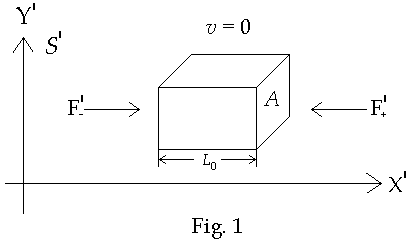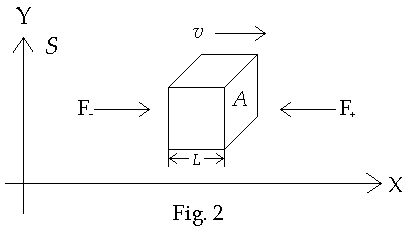
Inertial Energy vs. Mass
It is often said that (inertial) energy, E, and the so-called relativistic mass, m, (referred to below simply as mass) are the same thing, presumably due to the relation E = mc2. As such, it is claimed, there is no use for the later in relativity. m is then abandoned and only proper mass m0 is retained given the symbol m and referred to simply as mass. This debate dates back to the early 60’s, so this arguement is nothing new to special relativity. However such an argument is clearly wrong. Such erroneous conclusions may come about due to the lack of application in special relativity to anything which can be treated as a particle. However when an object is not a particle then the relation E = mc2 does not hold. I give an example of such a situation below.
Consider a square box at rest in the inertial frame S’ whose edges are parallel to the x’y'z' axes. Let there be equal and opposite forces (of which are distributed uniformly over the face) and which are parallel to the x’ axis. The force on the +x face is directed in the -x’ direction and the force on the -x’ face is directed in the +x’ direction. Then there then be a uniform pressure on each of those faces. Since these forces cancel there will be no acceleration of the box due to these forces. See Fig. 1 below

Now consider the same box from a frame S in which the box is moving in the +x direction as shown below in Fig. 2

The pressure on each face whose normal is parallel to the x’ axis in S’ frame is given by
![]()
Here T0xx is the stress as measured in the zero momentum frame. |F’x| = | F’+| = | F’-|. It can be shown that the momentum density as measured in S is given by [1]

Where r0 is the proper mass density (i.e. mass density as measured in the rest frame S’). The volume of the box in frame S is
![]()
Therefore the total momentum of the box as measured in S is given by

It can also be shown that the inertial energy density, uE, is given by [2]
![]()
It follows that the total inertial energy is given by

Comparing Eqs. (4) and (6) it is obvious that
![]()
This can only mean that mass, m, cannot be defined as E/c2 as many claim.
References:
[1] Introduction to Special Relativity, Wolfgang Rindler, Oxford University Press (1982). Page 151, Eq. (4.62) where.
[2] Ref 1, page 151, (4.63) where uE = rc2.